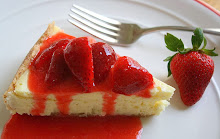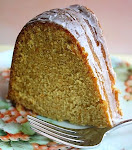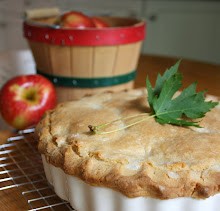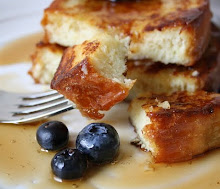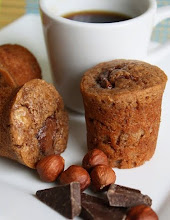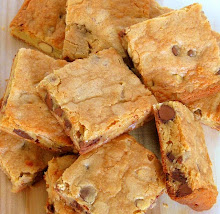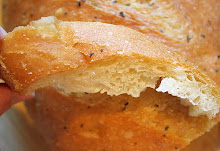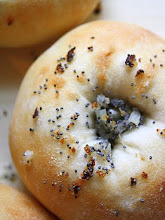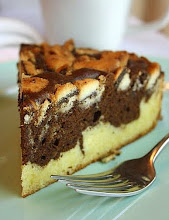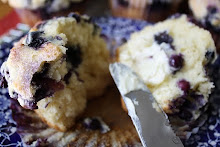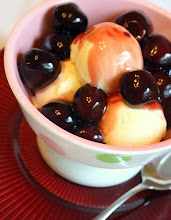I experienced a few intriguing culinary firsts this past week. First among them, I learned how to stretch and shape strudel dough in my Pastry I class. I've wanted to witness this procedure, live and in person, for years. It's pretty much a lost art among home bakers. Picture a small cluster of students, all clad in white, solemnly pulling a small lump of dough into a tissue-paper-thin sheet that's several feet long and wide. I felt kind of like I was participating in an ancient ritual. Chef Roger, our normally rather taciturn teacher, was clearly pleased to demonstrate and explain the technique, regaling us with funny anecdotes of the portly Austrian chef who trained him.

Secondly, I was introduced to the quince! A fruit that looks kind of like a cross between an apple and a pear, I'd never tasted one before. They're not common here in Michigan, and not a single student in our class could identify one when the Chef showed it to us. The following day, I discovered some at the grocery store and scooped up four to take home, so now I'm on the hunt for a good recipe to try them out.
Third on my list of firsts was the creation of a fondant-covered cake designed to look just like a wine bottle, made in my Theme Cakes class. I was pleased with the results but realized only after I brought it home that I'd made a spelling error in French, piped in curly script out of black buttercream, onto the bottle's label! (I should have spelled the word "petite" with no "e" at the end, using the masculine form!
Quelle tragedie! Je ne parle pas tres bien francais. Ah, well.)
The fourth notable first was the creation of this fluffy yogurt-based cheesecake, along with the accompanying brittle garnish made from Marcona almonds. I'd never made a cheesecake that was so dependent upon yogurt before, nor had I ever tried the famous Spanish Marconas.
I've read rave reviews in the past about these special almonds so when I stumbled upon them recently in Trader Joe's, I grabbed one of the little pouches. Consider yourself forewarned that these babies don't come cheap. They cost about the same as macadamias, but really are delicious. Not as hard and crunchy as regular almonds, they're also rounder and sweeter. A fine nut to use in brittle. I recommend them.
About this recipe . . .
Among my favorite dessert cookbooks is
Dolce Italiano: Desserts from the Babbo Kitchen, by Gina de Palma, and both recipes are adapted from it. I altered the recipes for the cake and the brittle a bit. I decided to flavor the cake with orange zest and a dab of orange extract, so it wouldn't be just plain vanilla.
And also, because I didn't have any mascarpone cheese on hand (though I
love that stuff!), I substituted cream cheese mixed slowly with a bit of heavy cream. And, I changed the brittle formula by using salted Marcona almonds instead of the indicated pine nuts. I figured the pine nuts' strong flavor in combination with the delicacy of the orange would be like putting a lion in a lace dress--not a good combo. Luckily, the changes I made worked out splendidly. Always a relief when this happens!
This crustless cake is rather airy and fragile in comparison to a typically dense cheesecake. It's a light fresh alternative to the norm, and the addition of the buttery, sweet-salty, crushed brittle topping adds unique texture interest. Very tasty indeed.
Orange Zest & Yogurt Cheesecake
with Marcona Almond Brittle
(For a printable version of this recipe, click here!)
For the cheesecake:
Preheat your oven to 350 degrees, and lightly butter a 10" springform pan. Sprinkle a couple teaspoons of granulated sugar in the pan to coat the bottom and sides; tap out the excess. Fit a couple sheets of foil tightly around the outside of the pan, beneath the bottom and up the sides. This will sit in a water bath while the cheesecake bakes, so the foil sheets really need to be able to keep the water out. You'll need a large pan that's deep enough to accommodate a couple of inches of water, and wide enough to hold your cake pan without it touching the sides.
3/4 cup granulated sugar
3 cups of plain, unflavored Greek-style yogurt
(I used the higher fat variety)
1 lb. of cream cheese, softened and slowly but thoroughly mixed with 3 Tbsp. heavy cream
(In lieu of this, the original recipe calls for 1 and 1/2 cups of mascarpone cheese; I didn't have that on hand so this was a good substitute.)
3 Tbsp. confectioners' sugar
3 large eggs, at room temperature
6 large egg yolks, at room temperature
1/2 tsp. kosher salt
1 and 1/2 tsp. vanilla extract
(I used 1 and 1/2 tsp. of vanilla bean paste instead; it is a thick liquid that visibly contains vanilla bean seeds)
1 tsp. orange zest
1/2 tsp. orange extract
In the large bowl of your electric mixer, using the paddle attachment, beat together the yogurt, the cream cheese-heavy cream mixture (or the mascarpone if you're using that), the 3/4 cup granulated sugar, and the confectioners' sugar on medium-low speed. Beat until it's smooth and creamy, for about 1 minute, stopping once to scrape the bottom and sides of the bowl.
One at a time, add in the egg yolks and the whole eggs, just until each one is incorporated, still at medium-low speed. Add in the salt and the vanilla extract or vanilla bean paste, then the zest and the orange extract.
Pour the batter into your prepared, foil-wrapped, springform pan. Place the springform into the larger pan and carefully add water to come about halfway up the sides of the springform. Be careful not to let any water splash onto the batter.
Cover both pans with a large sheet of foil, tenting it carefully so it doesn't touch the batter; make sure it covers the larger pan completely. Gently transfer this into your oven, on the middle rack.
Bake for 20 minutes, then rotate the pan 180 degrees. Bake for 20 more minutes, and then remove the foil tent. At this point, the original recipe says that the cheesecake should be "puffy but not cracked, jiggly but not liquid in the center." If that doesn't seem to describe what you see, just keep baking the cake until it's set.
(I had to bake mine about 15 minutes longer.)
Remove
the large pan from the oven. Let the cake cool in its springform pan, still set in the water bath, until the water feels lukewarm. Then remove the springform pan from the water, and continue cooling the cake until on a rack until there's no trace of warmth. At that point, remove the foil from the bottom and sides of the pan.
Chill the cake, in its pan, in the fridge at least 8 hours before serving. Before removing the sides of the springform, run a thin knife along the inner sides of the pan. Be sure to refrigerate any leftovers, if there are any!
To make the almond brittle:
You'll need a cooking thermometer with a probe, or a candy thermometer.
2 cups granulated sugar
1/4 cup water
4 Tbsp. unsalted butter
(doesn't need to be soft)
4 Tbsp. light corn syrup
2 tsp. kosher salt
1 and 1/4 cups Marcona almonds
Use parchment paper to fully line a 13" x 9" jelly roll pan. Grease the paper lightly with butter. In a large heavy saucepan, stir together the water and sugar. Add in the corn syrup and the butter.
Turn the heat on medium-high and immediately start monitoring the temperature with your thermometer. Bring the mixture to a boil.
With the heat now on high, continue cooking until the mixture looks golden brown and registers 350 degrees on your thermometer. Immediately turn off the heat and remove the thermometer. Stir in the salt, using a wooden spoon or heatproof spatula, then stir in the almonds. Make sure you coat all the nuts.
Turn the mixture out onto the buttered parchment in your jelly roll pan, and quickly spread it out so the nuts are in a single layer. (It will still be super hot at this point, so don't touch it with your hands.)
Let it completely cool before you try to break it into chunks. Store the pieces in an airtight container, and keep it in a cool, dry place. To serve it with the cheesecake, crush a couple of small pieces and sprinkle them over the top of individual slices.
(If you'd like to comment on this post, or to read any existing comments, please just click on the purple COMMENTS below!)















































